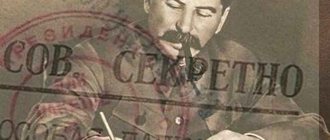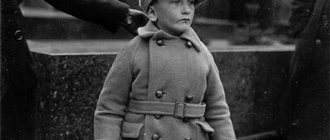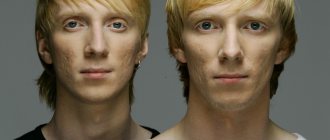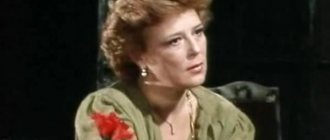Stalin's biography is one of the most interesting and frequently studied biographies. After all, being from a simple family, he managed to become the leader of the USSR, which he ruled for 29 years.
Stalin carried out many reforms, boosted the economy and transformed the country in record time after the total devastation of World War II.
Under his rule, the Soviet Union emerged as a nuclear-armed superpower.
By the way, pay attention to interesting stories from the life of Stalin. If you prefer the video format, then watch this video about Stalin.
So, we present to your attention a biography of Joseph Stalin.
Biography of Stalin
During Soviet times, tons of books were written about Stalin. Today, interest in it still has not cooled down, since it plays one of the most important roles for the world history of the 20th century.
In this article we will tell you about the key events in Stalin's biography that made him one of the most famous politicians in the history of mankind.
Childhood
Joseph Vissarionovich Stalin (real name Dzhugashvili) was born on December 9, 1879 in the Georgian city of Gori. He grew up in a poor, lower-class family.
15-year-old Joseph Dzhugashvili, 1894
His father, Vissarion, worked as a shoemaker and was a very despotic man.
Drunk to the point of unconsciousness, he brutally beat his wife, and sometimes even Joseph himself.
There was an episode in Stalin’s biography when he had to throw a knife at his father in order to protect himself and his mother from beatings.
According to local residents, one day his father beat little Joseph so badly that he almost broke his head.
Stalin's mother, Ekaterina Georgievna, came from a serf family and was poorly educated.
From a young age she had to earn a living through hard work.
Despite the fact that she also often beat her son, she, at the same time, loved him to death and protected him from all everyday worries.
Joseph Vissarionovich Stalin and his era
Perhaps there is no more controversial figure in our history than Joseph Vissarionovich Stalin. This is a totalitarian leader who practically arrogated the highest position to himself, and the author of numerous repressions, and the leader of the victorious country in World War II. A very interesting and colorful character.
It is difficult, even in our time, to find a person who does not know who Stalin is. He aroused irritation in some, anger in others, respect in others, and fear in others. But none of his contemporaries remained indifferent to this charismatic and multifaceted politician.
Joseph Vissarionovich Stalin
Let's try to immerse ourselves in his world for a while and at least slightly lift the veil of history over his biography and the most striking events of his life.
Stalin's appearance
Joseph Dzhugashvili had various physical defects. He had fused second and third toes on his left foot, and his face was covered in pockmarks.
When he was 6 years old, he was hit by the wheels of a phaeton (an open-body car), as a result of which he seriously injured his arms and legs.
Throughout his life, Stalin's left arm was not fully extended. In the future, due to these injuries, he will be declared unfit for military service.
Myth 11. Stalin was killed.
- Who benefited from this? Not Beria - Stalin was going to unite the Ministry of Internal Affairs and the MGB and put Beria in charge. Khrushchev? According to his recollections, on February 28, Stalin allegedly gathered his inner circle in the Kremlin to watch a film. Then we went to the dacha, where they allegedly ate and drank until the morning. But in the log of Stalin’s visits to the Kremlin there are no notes about the visit of guests on February 28, nor that the leader himself was there. His order on the dinner menu: steamed potato cutlets, soup, juice and curdled milk - clearly did not expect guests. On March 1, there was no movement in Stalin’s office all day. Why didn’t any of the guards disturb the “owner”? She was subordinate to the head of the MGB, Ignatiev; “laboratory X”, which studied the effects of poisons on humans, was also subordinate to him. Only in the evening, when the courier arrived with the mail, the guards entered Stalin and saw him lying on the floor. They put him on the sofa. And only on the morning of March 2 (!) the doctors arrived. Paralysis and stroke were diagnosed. Death was recorded on March 5 at 21.50.
— Are there any corrections in Stalin’s medical history journal?
— The ECG transcript says that myocardial changes occurred not in the anterior wall, as it should, but in the posterior wall of the ventricle. The luminaries of medicine are not so wrong. The leader died in the evening, and the autopsy began at 4 am. And not in a special laboratory of the Mausoleum, as was supposed, but in an unsuitable room. Why was there a hurry, the autopsy report was reprinted several times? Due to inconsistencies, the poisoning version arose. But the official version is a stroke.
The same boat fired at by border guards, in which Stalin (second from left) almost died.
Education
An interesting fact is that until the age of 8, Stalin did not know the Russian language at all. Years of biography 1886-1888, Joseph, at the request of his mother, was taught Russian by the children of a local priest.
After that, he studied at the Gori Theological School, which he graduated in 1894. Then his mother sent him to the Tiflis Theological Seminary, because she really wanted her son to become a priest.
However, this never happened. It is interesting that it was in the seminary that Joseph first heard about Marxism.
The 15-year-old teenager was so captivated by the new political movement that he began to seriously engage in revolutionary activities. On May 29, 1899, in his fifth year of study, Stalin was expelled from the seminary “for failure to appear for exams for an unknown reason.”
In 1931, in an interview with the German writer Emil Ludwig, when asked “What prompted you to be an oppositionist?” Possibly mistreatment from parents? Stalin replied:
"No. My parents treated me quite well. Another thing is the theological seminary where I studied then. Out of protest against the mocking regime and the Jesuit methods that existed in the seminary, I was ready to become and actually became a revolutionary, a supporter of Marxism...”
Literally immediately after being expelled from the seminary, the young man decides to join the social democratic movement “Mesame Dasi”.
This led to him becoming a professional revolutionary in 1901.
Myth 9. Of all the children, Stalin loved only Sveta
— Stalin did not see his eldest son, Yakov, who was raised by relatives in Tiflis for many years. He came to Moscow in 1921. After school, Yakov secretly married the daughter of a priest from his father. And when he got divorced and tried to shoot himself, Stalin called his son a “blackmailer.” Yakov graduated from the Moscow Institute of Transport Engineers, and then, on the advice of his father, entered the evening department of the Artillery Academy of the Red Army. When he was captured, Stalin allegedly abandoned him in trouble. But in Zhukov’s memoirs there is a moment that Stalin was very worried about the drama with his son. The special services told me that special groups were preparing to free Yakov. But he was constantly transferred from one camp to another.
The eldest of Stalin’s supposed “illegitimate sons,” Konstantin Kuzakov, became a prominent official in the Ministry of Culture.
And yes, Stalin did not exchange the captured Field Marshal Paulus for his son. However, I have not seen any data on a direct exchange offer. When the captured documents were taken in 1945, there were protocols of Yakov’s interrogations and evidence of his death.
Stalin was strict but fair towards his son Vasily. Since July 1942, Vasily has been fighting on the fronts of the Great Patriotic War. Was injured. During the war, he received official reprimands from his father several times and was demoted for violations.
— Did you remember about sons born in exile?
— They wrote that while in exile in Solvychegodsk, Stalin had a relationship with the widow Maria Kuzakova, who gave birth to a son, Konstantin, after Stalin’s departure. Kuzakov’s career was a success - he headed the cinematography department and the publishing house “Iskusstvo” in the Ministry of Culture.
A more interesting story is from the Krasnoyarsk village of Kureyki. They claim to be cohabiting with 14-year-old Lydia Pereprygina, who gave birth to Stalin’s son Sasha. But at the heart of everything written about this are three paragraphs from a note from KGB head Ivan Serov to Nikita Khrushchev in June 1956. In the first part of the note, Serov reports on a publication in Life magazine that Stalin was an agent of the secret police - and the head of the KGB proves that this is a fake. Then he reports on documents from the Krasnoyarsk archive about Stalin’s exile. And at the end he writes that there was a “conversation about the Pereprygins.” And a few years ago, in the archives, I came across a letter from the secretary of the Central Committee of the party, Aristov, to Khrushchev, who writes that in 1946, when he was the first secretary of the Krasnoyarsk regional committee, Stalin’s assistant Poskrebyshev approached him. He asked me to find out how the Pereprygins were doing. And Aristov sent instructor Sirotenko to Kureika. He found out about the history of cohabitation. And they reported to Stalin that they were alive and well.
The youngest son, Alexander Davydov, is an officer.
It seems to me that this story was invented in 1956 by Aristov, who oversaw the KGB, the head of the KGB, Serov, and Khrushchev.
Revolutionary activities
The period of Stalin's biography of 1902-1913 was full of various events. He was arrested 6 times and sent into exile, from which he made successful escapes several times.
After a split occurred in the party into “Mensheviks” and “Bolsheviks” in 1903, Stalin supported the latter. This choice was made largely because Vladimir Lenin, whom Stalin admired, was on the side of the Bolsheviks.
At the direction of Lenin, Koba managed to create quite a lot of underground Marxist circles in the Caucasus.
Since 1906, Stalin was a participant and organizer of various expropriations (deprivation of property). All the stolen money was intended for the needs of the party and to finance the underground activities of the revolutionaries.
In 1907, Stalin became one of the leaders of the Baku Committee of the RSDLP. Since he was a very literate and well-read person, he also participated in the creation of the newspapers Zvezda and Pravda.
Photo of Stalin after his arrest in March 1908
In 1913, Dzhugashvili wrote an article “Marxism and the National Question,” which received good reviews from his comrades.
In the same year, he was arrested and sent into famous exile in the Turukhansk region.
This link is mentioned by Vladimir Vysotsky in Yuz Aleshkovsky’s song “Comrade Stalin, you are a great scientist.”
Career of Joseph Stalin
The next stage in the biography of Joseph Dzhugashvili was revolutionary activity. In 1899 he became a member of the Tiflis and Batumi party committees. For members of these organizations, rallies and secret appearances were often interspersed with raids on banks and robberies, the funds from which went to the development of the young RSDLP.
From 1902 to 1913, Stalin was arrested 8 times. As a rule, the main sentence for Joseph was most often exile. However, the tough hand of the law only fueled the ardor of the young, ambitious revolutionary. In 1904, he became the main organizer of the Baku strike, as a result of which the workers received concessions from the oil industrialists.
In 1905, during the Finnish party conference, Koba (one of Stalin’s underground nicknames) met Vladimir Ulyanov-Lenin. Later, Joseph was a participant in the IV and V party congresses, which took place in Sweden and Great Britain.
Since 1912, Joseph Vissarionovich decided to replace his surname with the party nickname Stalin. A year later, the revolutionary was again sent into exile, from which he returned in 1917. Upon his return from exile, Joseph Stalin headed the editorial office of the newspaper Pravda. The purpose of his current activities was the preparation of an armed coup.
Power
The October Socialist Revolution accelerated Stalin's rise up the political career ladder. An ardent revolutionary and a threat to banks, he joined the Council of People's Commissars and became a member of the Party's Central Committee. During the civil war, he established himself as an outstanding politician and talented military leader.
October Revolution of 1917
In the spring of 1917, Stalin was a member of the Politburo of the Central Committee of the RSDR, and was also part of the Military Revolutionary Center for the leadership of the armed uprising.
In this regard, he took an active part in the preparation of the coup d'etat.
The party was pleased with his actions, since he coped with any tasks that were entrusted to him, and was absolutely devoted to the ideas of the Bolsheviks.
From the beginning of the Civil War until its end, Stalin held many responsible positions.
According to the recollections of his contemporaries, no matter what he did, he managed to do his job perfectly.
Party work
In 1922, a most important event took place in Stalin’s biography. He becomes the first Secretary General of the Central Committee. It should be noted that initially this position implied only the leadership of the party apparatus.
However, over time, it was turned by Stalin into a post with greater powers. The uniqueness of the position was that it was the Secretary General who had the right to appoint grassroots party leaders.
Thanks to this, the insightful and cautious Stalin selected the most devoted people for himself. In the future, this will help him create and lead a vertical of power.
Power struggle
In 1924, after Lenin's death, many communists from the Central Committee wanted to take his place. Dzhugashvili was among them. Wanting to become the new leader, he proclaimed a course toward “building socialism.”
In order for fellow party members to support this idea, he often quoted Lenin, emphasizing his commitment to socialism.
Stalin's main opponent in the struggle for power was Leon Trotsky. However, he managed to beat him. The majority of party members voted for Stalin's candidacy.
As a result of this, Joseph Vissarionovich Stalin became the first person in the country, and almost single-handedly ruled it from 1924 to 1953, until his death.
First of all, he focused his attention on the industrialization of the country and forced collectivization, which was canceled only in the spring of 1930.
In addition, he did everything possible to get rid of the kulaks. During the years of Stalin's rule, millions of people were evicted or sent into exile.
In the future, collectivization led to a wave of protests among peasants. Riots broke out in one place after another, many of which were suppressed by force of arms.
Myth 3. Stalin was an anti-Semite
— A number of historians argue that “Stalinist anti-Semitism” is behind the Stalin-Trotsky conflict. But the tension between them is a disagreement about the fate of Russia and a war for power. In the 20s and 30s, Stalin did not experience antipathy towards the Jews. In 1923, there were 3 Jews on Stalin’s team, and in 1936, 9 People’s Commissars of the USSR were Jews.
— Did Stalin’s attitude towards Jews change?
— After the war, the state of Israel appeared, largely thanks to Stalin: our voice in the UN influenced it. But then the first Israeli ambassador to the USSR, Golda Meir, came to the synagogue in Moscow and was greeted by thousands of Jews. Soviet Jewish front-line soldiers write statements: let us into Israel, we want to defend our state. This shocked Stalin: the Jews had a Soviet homeland - and suddenly another, “historical” one arose. He remembered the recent collaboration of a number of peoples of the USSR. And he began to fight. Not with the Jewish ethnic group - with its elite.
— Were there personal reasons?
— Stalin’s 17-year-old daughter Svetlana fell in love with 40-year-old married playwright Alexei Kapler. He begins to have an affair with a tenth-grader - they report this to the leader. The result is that in 1943 Kapler was sent to Vorkuta. Svetlana would later write that Kapler became the person because of whom the relationship with her father went wrong forever. In 1944, she married MGIMO graduate Grigory Moroz - Stalin did not welcome the marriage. Moroz is part of the close circle of Solomon Mikhoels, head of the Jewish Anti-Fascist Committee. Later, in the investigation documents in the JAC case, it was stated that Mikhoels allegedly said that it was not possible to get close to Stalin, the marriage of Svetlana and Moroz was broken, it needed to be restored. The evidence ends up on Stalin’s desk, and he tells his daughter: “The Zionists also gave you your first husband.” Referring to the marriages of a number of associates.
Father of Nations
In the mid-30s, Joseph Stalin became the sole leader of the Soviet people. Former party leaders such as Trotsky (see interesting facts about Trotsky), Bukharin, Zinoviev, Kamenev and others were subjected to repression because they took an anti-Stalinist position.
Researchers claim that the biographical period of 1937-1938 was the bloodiest in the entire history of Stalin's reign.
In a short period of time, millions of Soviet citizens of very different social status were repressed. Even more people ended up in labor camps.
At the same time, the cult of the leader’s personality began to actively develop. Stalin was called nothing less than the “father of nations.”
The Great Patriotic War
When Adolf Hitler attacked the Soviet Union and the Great Patriotic War began, Stalin was appointed Supreme Commander of the USSR Armed Forces.
Without his participation, not a single military operation was discussed, and the war strategy was agreed upon with the leader personally.
In 1942, the anti-Hitler coalition consisted of 26 states. The coalition was led by the Big Four: the USSR, Great Britain, the USA and China.
Joseph Stalin represented his country at negotiations with allied countries in Tehran (1943), Yalta (1945) and Potsdam (1945).
As a result of the bloodiest war in history, the losses of military personnel and civilians amounted to more than 26 million Soviet people.
The Soviet army made the greatest contribution to the victory over the Nazis, becoming the main victorious country. It was the soldiers of the USSR who liberated most of the European countries.
It is important to note that immediately after the war this fact could not be denied or disputed, so the Allies, at least verbally, expressed gratitude to the USSR.
However, today, unfortunately, the history of the Second World War is being actively rewritten.
Post-war years
In the post-war years, much changed in Stalin's biography. After all, he was the main country that defeated world evil.
In this regard, the “father of nations” wanted to create a world socialist system, which ran counter to the interests of Western countries.
As a result of this and other factors, the Cold War began, which affected politics, economics, military power of countries, etc. The main confrontation took place between the USSR and the USA.
On June 27, 1945, Joseph Stalin was awarded the title of Generalissimo of the Soviet Union. A year later, he was approved as Chairman of the Council of Ministers of the USSR and Minister of the Armed Forces of the USSR.
After the end of the war, totalitarianism resumed again in the Soviet Union. The autocratic regime did not allow people to have their own point of view, and freedom of speech was strictly controlled by official censorship.
By order of the leadership, constant purges were carried out affecting both the state apparatus and ordinary people. At the same time, anti-Semitic sentiments began to appear in society.
Stalin's nickname
For example, Stalin had an acquaintance from Batumi, Nizharadze - his last name became one of the nicknames of young Joseph. And Stalin escaped from exile in Vologda using Chizhikov’s real passport. At the IV Party Congress, a certain Ivanovich was registered as a representative from the Tiflis branch of the party - also the working pseudonym of Dzhugashvili. However, all these were just small episodes in the life of the Bolshevik, who later became a great politician.
Stalin's party nickname
When choosing nicknames and pseudonyms, Stalin showed particular predilection for two letters of the Russian alphabet - “S” and “K”; as a rule, his “names” began with them. Perhaps this was partly due to his native name Soso. This is where pseudonyms such as Sozeli and Soselo came from - diminutives. But it’s not good for a politician to be little Osenka (that’s how these names are roughly translated into Russian). “Kote”, “Kato” - the mother’s name as a pseudonym also did not last long. As Stalin grows, his thirst for greatness awakens. That is why Koba became one of his favorite pseudonyms. What is its origin?
For example, there is this option. This was the name of the hero of the novel “The Patricide,” written by the then popular writer in Georgia Alexander Kazbegi, a noble robber who was the idol of young Soso. According to V. Pokhlebkin, this pseudonym comes from the name of the Persian king Kavad (in another spelling Kobades), who conquered Georgia and made Tbilisi the capital of the country; in Georgian the name of the Persian sounds like Koba. Kavad was known as a supporter of Mazdakism, a movement that promoted early communist views. Traces of interest in Persia and Kavad are found in Stalin’s speeches of 1904-07.
Ideals of Stalin
Some facts of Stalin's biography (ideals, prison, escape from it with the help of a certain woman) surprisingly coincided with the biography of Joseph Vissarionovich himself. And the fact that this was the name of a tsar, and even a conqueror, could not leave Stalin indifferent due to his ambition. It is not for nothing that the word “satraps” was one of Stalin’s favorite expressions. However, the pseudonym Koba was suitable only while Dzhugashvili’s field of activity was Transcaucasia, where people were well acquainted with the local color and history. After entering a wider arena, transferring his aspirations to Russia, the pseudonym Koba became inappropriate, since it ceased to evoke the necessary associations among his party comrades: well, what Russian knew about some Georgian king?
Stalin is a pseudonym that best reflected Koba’s inner essence. The king, shrouded in Eastern mysticism and a certain amount of magic, is replaced by a specific, clear symbol: steel. Brief, succinct, unbending, simple and inevitable - that’s how this word sounds. It is tougher than iron, clear and understandable to everyone. In addition, it has a clear indication of the “Russianness” of the owner. Lenin - Stalin - it looks like it, doesn’t it? For some time the initial “K” reminds me of Kobe. in the signature: K. Stalin - this is how the future leader has signed since 1913. And it is not surprising that this particular pseudonym later became a surname. After all, this has often happened in Russian history: the surname should reflect the inner essence of the owner. “Dzhugashvili” – what’s great here? Although there is a version that the word “juga” is translated from ancient Georgian as “steel”. But this version still seems unfounded. After all, it was the presence of this very steel in the character of Joseph Vissarionovich that made the heirs of his pseudonym so unhappy, who did not have the necessary firmness.
How did the name “Stalin” come about?
They say that this pseudonym was invented by Stalin himself, who relied only on the fact that the pseudonym should have been:
– sounding Russian and Russian in design;
– extremely serious, significant, impressive in content, not allowing any interpretations or misunderstandings;
– it had to have a deep meaning, and at the same time not be particularly conspicuous, not overpowering, and be calm;
– it should be easy to pronounce in any language and phonetically be close to Lenin’s pseudonym, but in such a way that the similarity is also not felt directly.
How many years did Stalin rule?
Actually, Joseph Dzhugashvili finally became Stalin in 1912. Before that, he “tried on” many consonant pseudonyms - Solin, Salin, Soselo, Stephin. In communicating with Lenin, the future head of state did not skimp on compliments, giving Vladimir Ilyich the enthusiastic epithet “mountain eagle.” Lenin responded with the nickname “wonderful Georgian,” which he used more than once. In addition, the leader of the world proletariat called Stalin “a fiery Colchian.” It is curious that after Lenin’s death Stalin himself began to be called “mountain eagle”.
During the Great Patriotic War in the Soviet Union, Stalin was usually addressed not by his first name, patronymic or military rank (“Comrade Marshal (Generalissimo) of the Soviet Union”), but simply “Comrade Stalin.” During the war, the Allied leaders naturally also had their own nicknames. Churchill and Roosevelt, officially addressing the leader of the USSR as “Marshal Stalin,” called him “Uncle Joe” among themselves. However, with the beginning of the Cold War, this nickname became history.
"The Great Helmsman" For the first time, the official Soviet press called the leader of the USSR this way in September 1934. The very combination “Great Helmsman” is of Christian origin, like many other epithets and slogans of Soviet propaganda. The outdated Russian word “helmsman” means a person sitting at the stern of a ship, in other words, a helmsman. Thus, the epithet in relation to Stalin meant nothing more than “standing at the helm of the country.” Later, the leader of the Chinese Communist Party, Mao Zedong, began to be called this, and, as a rule, this epithet is associated with him today.
Stalin - Father of Nations
Perhaps the most famous of the epithets applied to Stalin appeared long before the emergence of the USSR and is of Western European origin. The kings of France, such as Louis XIII or Henry IV, were called “Fathers of Nations.” This nickname was assigned to Stalin thanks to Soviet publicists from the mid-1930s. It is noteworthy that it was this image that was reinforced by the public appearances of the head of state: from 1935, photographs depicting Stalin with small children and sometimes their parents from different parts of the Soviet Union began to regularly appear in newspapers. Thus, he figuratively became the “father” of children with very different national roots.
Beginning in the 1930s, the image of Stalin began to take shape especially dynamically in the Soviet media. Then the famous pipe and the green overcoat with tapered trousers appeared in the public consciousness. And the press described Stalin with a huge number of epithets, one more colorful than the other - “great leader and teacher”, “wise father”, “architect of communism”, “locomotive of the revolution”, “fighter and falcon”.
Add your comment
Achievements
At the same time, despite the fact that Stalin’s biography has many dark spots, it is fair to note his achievements.
During the reign of the “Father of Nations,” by the end of the 40s, industry developed so quickly that by 1950 it exceeded its indicators by 100% compared to 1940.
An interesting fact is that in 2009, Vladimir Putin said that under Stalin’s leadership the country “transformed from an agricultural one to an industrial one,” which is simply impossible to argue with.
In addition, the leader attached great importance to increasing the military power of the USSR. He was also the initiator of the “atomic project”, thanks to which Soviet Russia became a superpower.
A curtain
The causes of death of the leader of the peoples are very prosaic - stroke. But the circumstances of death are very interesting. We will definitely look at them in one of the following articles. Stalin died on March 5, 1953. The official cause is a diagnosis of cerebral hemorrhage. The dates of birth and death known to us (1878 - 1953) indicate that he was 74 years old. He was buried on Red Square in Moscow (necropolis near the wall).
In order to consolidate your knowledge, you can watch any documentary film dedicated to Joseph Stalin. Feature films were also made.
Personal life
Stalin's first wife was Ekaterina Svanidze, whom he married in 1906. In this marriage they had a son, Yakov.
However, the following year Catherine died of typhus. For Stalin, this was a real tragedy from which he could not recover for a long time.
Stalin's second wife is Nadezhda Alliluyeva. She gave birth to the leader two children: Vasily and Svetlana.
Stalin and his wife Nadezhda Sergeevna Alliluyeva
Stalin with his children










